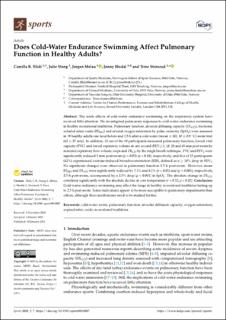Does cold-water endurance swimming affect pulmonary function in healthy adults?
| dc.contributor.author | Illidi, Camilla Rønn | |
| dc.contributor.author | Stang, Julie | |
| dc.contributor.author | Melau, Jørgen | |
| dc.contributor.author | Hisdal, Jonny | |
| dc.contributor.author | Stensrud, Trine | |
| dc.date.accessioned | 2021-11-08T15:13:33Z | |
| dc.date.available | 2021-11-08T15:13:33Z | |
| dc.date.created | 2021-01-18T14:13:25Z | |
| dc.date.issued | 2021 | |
| dc.identifier.citation | Sports. 2021, 9(1), Artikkel 7. | en_US |
| dc.identifier.issn | 2075-4663 | |
| dc.identifier.uri | https://hdl.handle.net/11250/2828439 | |
| dc.description | This article is an open access article distributed under the terms and conditions of the Creative Commons Attribution (CC BY) license (https://creativecommons.org/licenses/by/4.0/). | en_US |
| dc.description.abstract | Abstract: The acute effects of cold-water endurance swimming on the respiratory system have received little attention. We investigated pulmonary responses to cold-water endurance swimming in healthy recreational triathletes. Pulmonary function, alveolar diffusing capacity (DLCO), fractional exhaled nitric oxide (FENO) and arterial oxygen saturation by pulse oximetry (SpO2) were assessed in 19 healthy adults one hour before and 2.5 h after a cold-water (mean ± SD, 10 ± 0.9 ℃) swim trial (62 ± 27 min). In addition, 12 out of the 19 participants measured pulmonary function, forced vital capacity (FVC) and forced expiratory volume in one second (FEV1) 3, 10, 20 and 45 min post-swim by maximal expiratory flow volume loops and DLCO by the single breath technique. FVC and FEV1 were significantly reduced 3 min post-swim (p = 0.02) (p = 0.04), respectively, and five of 12 participants (42%) experienced exercise-induced bronchoconstriction (EIB), defined as a ≥ 10% drop in FEV1. No significant changes were observed in pulmonary function 2.5 h post-swim. However, mean FENO and DLCO were significantly reduced by 7.1% and 8.1% (p = 0.01) and (p < 0.001), respectively, 2.5 h post-swim, accompanied by a 2.5% drop (p < 0.001) in SpO2. The absolute change in DLCO correlated significantly with the absolute decline in core temperature (r = 0.52; p = 0.02). Conclusion: Cold-water endurance swimming may affect the lungs in healthy recreational triathletes lasting up to 2.5 h post-swim. Some individuals appear to be more susceptible to pulmonary impairments than others, although these mechanisms need to be studied further. | en_US |
| dc.language.iso | eng | en_US |
| dc.subject | alveolar diffusion capacity | en_US |
| dc.subject | cold-water swim | en_US |
| dc.subject | expired nitric oxide | en_US |
| dc.subject | oxygen saturation | en_US |
| dc.subject | pulmonary function | en_US |
| dc.subject | recreational triathletes | en_US |
| dc.title | Does cold-water endurance swimming affect pulmonary function in healthy adults? | en_US |
| dc.type | Peer reviewed | en_US |
| dc.type | Journal article | en_US |
| dc.description.version | publishedVersion | en_US |
| dc.rights.holder | © 2021 by the authors | en_US |
| dc.source.pagenumber | 12 | en_US |
| dc.source.volume | 9 | en_US |
| dc.source.journal | Sports | en_US |
| dc.source.issue | 1 | en_US |
| dc.identifier.doi | 10.3390/sports9010007 | |
| dc.identifier.cristin | 1873325 | |
| dc.description.localcode | Institutt for idrettsmedisinske fag / Department of Sports Medicine | en_US |
| dc.source.articlenumber | 7 | en_US |
| cristin.ispublished | true | |
| cristin.fulltext | original | |
| cristin.qualitycode | 1 |
Tilhørende fil(er)
Denne innførselen finnes i følgende samling(er)
-
Artikler / Articles [2096]
-
Publikasjoner fra Cristin [1084]
